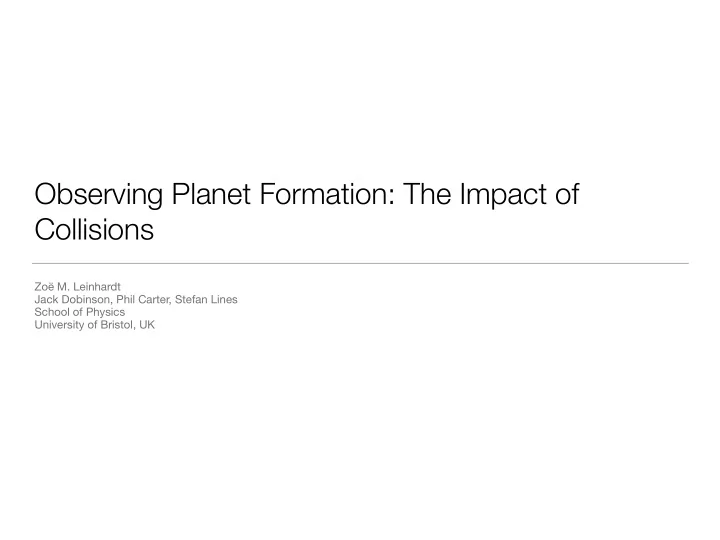

Observing Planet Formation: The Impact of Collisions Zoë M. Leinhardt Jack Dobinson, Phil Carter, Stefan Lines School of Physics University of Bristol, UK
Snapshots from Observations Hubble Space Telescope Orion Nebula Proplyd Atlas 2009
Snapshots from Observations 100 10 Mass x sin(i) [M J ] 1.0 0.1 0.01 1e-3 1e-4 0.01 0.1 1.0 10 100 Semi-major Axis [AU]
Planet Formation Cartoon Accretion Disk Mature Star Molecular Cloud (H 2 ) & Young Star & Planets [Orion Nebula] [Proplyds] [HR 8799] This is the process that we would like to understand. It is effectively invisible.
Planetesimal Collision Outcomes Partial Hit-&-Run Disruption Catastrophic Perfect Merge Disruption Planetesimals in the gravity regime > 1km Evolution code: PKDGRAV (N-body) Collision model: EDACM
Empirically Derived Analytic Collision Model (EDACM) Material specific parameter basalt, 1-100 km (Benz & Asphaug ’99) basalt, 2-50 km (LS09) µ ( φ +3) / (2 φ +3) R 9¯ µ/ 2 R 3¯ µ ) + q g ( ρ 1 G ) 3¯ basalt RD = q s ( S/ ρ 1 ) 3¯ µ/ (3 − 2 φ ) µ V ∗ (2 − 3¯ C 1 V ∗ (2 − 3¯ µ ) Q ∗ C 1 (Jutzi et al. ‘10) Strength Regime Gravity Regime ice, 50 km (LS09) Coupling parameter ~ 0.35 momentum scaling rubble piles, 1-50 km Leinhardt & Stewart 2009, Leinhardt et al. 2000 Leinhardt & Stewart 2012
A. Collision parameters B. Catastrophic disruption criteria * + θ > 0 V V i θ * (J/kg) U = Gravitational binding energy + M M < 1 p t α M p + M t ∗ = M c µ , , RD M p t for Q c U ∗ = * D Q R Specific impact energy Radius of total mass (km) ( ) 2 α α M M ( M + M ) V p t p t i Q = ( ) * ∗ * R ( ) = F Q c M , , M M , , θ V , µ 2 α M + M RD tot p t p t C. Mass of the largest remnant D. Maps of collision outcomes θ [deg] 30 45 60 90 1.0 20 M p :M t =1:10 0.8 Leinhardt & Stewart (2012) Erosion Partial Accretion 15 M lr / M tot 0.1M t Merging 0.6 Linear near Q * RD Hit & Run esc 0.4 i / V 10 0.5M tot V Power law slope η 0.2 for Q R > 1.8 Q * RD 0.9M t 5 0.0 0 1 2 3 4 5 M t +0.5M p Q R /Q* 0 RD * , ( ) 0 0 0.50 0.50 0.70 0.70 0.86 0.86 1 1 = F M M Q Q η lr tot R RD Impact Parameter b Impact Parameter b
Numerical Method: Quiet Terrestrial Planet Formation Planetesimal disk Desktop + 3. Planetesimal disk : 1. Evolution code : Standard surface density (MMSN) N-body gravity code PKDGRAV Ʃ = Ʃ 1 (a/1AU) -1.5 , Ʃ 1 =10 g/cm 2 0.5 < a < 1.5 AU 2. Collision Model : N init = 10 4 , R ~ 100 km, f = 6 a) perfect merging; b) RUBBLE; c) EDACM No gas
Results: Formation of Embryos Leinhardt et al. in press
Results: Degree of Planetesimal Mixing Embryo Composition at 400,000 yr (14.4 Myr) RUBBLE EDACM 0 . 5 0 . 6 0 . 7 0 . 8 0 . 9 1 . 0 1 . 1 1 . 2 1 . 3 1 . 4 1 . 5 Semi-Major Axis [AU] Each colour shows amount (% mass) of material both resolved and • unresolved accreted from a particular semi-major axis Both RUBBLE and EDACM show limited mixing • Leinhardt et al. in press
Results: Planetesimal Collision Outcomes Leinhardt et al. in press
Results: Instantaneous Dust Images 50,000 (1.8 Myr) 100,000 (3.6 Myr) 200,000 (7.2 Myr) 400,000 (14.4 Myr) Unresolved Debris Surface Density 1x10 6 Flux (850 μ m) � RADMC3D � Jy/sr � � � 0 Quiet runaway and oligarchic growth not observationally visible with ALMA But what if the scenario is not quiet? What if there is a perturber? Leinhardt et al. in press
Transitional (& Pre-transitional) Disks MWC 758 SAO 206462 Muto et al. 2012 Grady et al. 2013 PDS 70, pre-transitional disk Kraus & Ireland 2012 Hashimoto et al. 2012
Numerical Method: Quiet Terrestrial Planet Formation Planetesimal disk Bluecrystal Supercomputer UoB + 3. Planetesimal disk : 1. Evolution code : Standard surface density (MMSN) N-body gravity code PKDGRAV Ʃ = Ʃ 1 (a/1AU) -1.5 , Ʃ 1 =10 g/cm 2 0.5 < a < 10 AU 2. Collision Model : N init = 10 6 , R ~ 100 km, f = 1 EDACM+ Gas, Jupiter-mass planet @ 2.8 AU
Numerical Method: EDACM+ M p /M t = 0.25 v = 50 m/s, b = 0.9 v = 38 m/s, b = 0.0 Resolved Rubble-pile Collision EDACM+ Leinhardt et al. in press
Results: Collisional Stirring from a Circular Planet 10xMax NoPlanet 0.0 Dobinson, Leinhardt et al. in prep.
Results: Planetesimal Collision Outcomes No Planet (control) Circular Planet Eccentric Planet Eccentric Planet (e=0.1) (e=0.2) Dobinson, Leinhardt et al. in prep.
Results: Collisional Stirring from an Eccentric Planet 10xMax NoPlanet 0.0 Dobinson, Leinhardt et al. in prep.
Conclusions & Caveats • Our current work suggests it will be hard to observe planetesimal evolution if the growth environment is dynamically quiet • A more active environment such as an embedded planet increases dynamical temperature will result in more debris • No primordial dust - needed to create most realistic synthetic images - working on it • In transitional disk work - just one planet - wide gap transitional disks would require more than one • Location of the planet picked to make simulations numerically practical - not at observed location of gaps
Recommend
More recommend